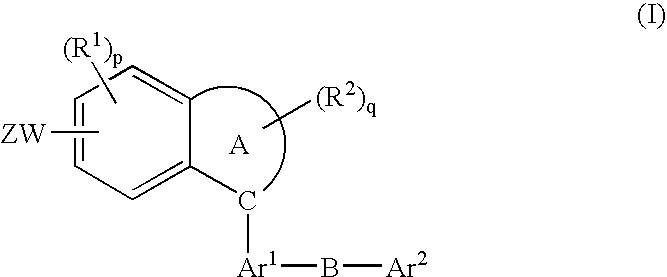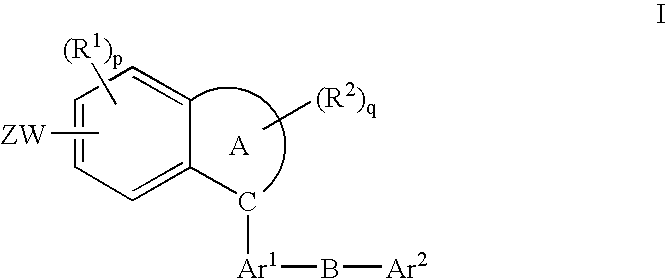Fused-Aromatic Compounds Having Anti-Diabetic Activity
- Summary
- Abstract
- Description
- Claims
- Application Information
AI Technical Summary
Benefits of technology
Problems solved by technology
Method used
Image
Examples
example 1
(2S)-2-({3-[4-(4-chlorophenoxy)-2-propylphenyl]-1-benzofuran-5-yl}oxy)propanoic acid
[0191]
Step 1. Preparation of 4-chlorophenoxybenzaldehyde
[0192]A heterogeneous mixture of 4-chlorophenol (14.1 g, 0.11 mmol), 4-fluorobenzaldehyde 12.4 g, 0.1 mmol) and CS2CO3 (65.0 g, 0.20 mmol) in DMF (400 mL) was stirred at 90° C. for 6 h. The reaction mixture was poured into water (1.2 L) and extracted with ethyl acetate (2×200 mL). The organic phase was washed with water (2×100 mL), dried over magnesium sulfate and concentrated to give essentially pure 4-chlorophenoxybenzaldehyde, which was used directly in the next step.
Step 2. Preparation of 4-(4-chlorophenoxy)phenol
[0193]The crude aldehyde from step 1 (23.3 g, 0.10 mmol) was dissolved in dichloromethane (500 mL), and m-chloroperbenzoic acid (70%, 50.0 g, 0.20 mmol) and sodium bicarbonate (25.2 g, 0.30 mmol) were added. The resulting heterogeneous mixture was stirred and heated under reflux for 2 h and then quenched with an aqueous solution of ...
example 2
(2S)-2-({6-chloro-3-[4-(4-chlorophenoxy)-2-propylphenyl]-1-benzofuran-5-yl}oxy)propanoic acid
[0207]
[0208]The title compound was prepared following the same procedure as described for Example 1 except that, in step 9 of Example 1, 3-chloro-4-methoxyphenol was used instead of 4-methoxyphenol.
[0209]1H NMR (500 MHz, CD3OD) δ 7.74 (s, 1H), 7.66 (s, 1H), 7.38 (d, J=9.0 Hz, 2H), 7.28 (d, J=8.5 Hz, 1H), 7.04 (d, J=9.0 Hz, 2H), 7.00 (d, J=8.5 Hz, 1H), 6.96 (dd, J=8.5, 2.5 Hz, 1H), 6.90 (s, 1H), 4.60 (m, 1H), 2.55 (t, J=7.5 Hz, 2H), 1.62 (d, J=7 Hz, 3H), 1.45 (m, 2H), 0.77 (t, J=8.5 Hz, 3H).
example 3
(2S)-2-({3-[4-(4-chlorophenoxy)-2-propylphenyl]-1,2-benzisoxazol-5-yl}oxy)propanoic acid
[0210]
Step 1. 4-(4-chlorophenoxy)-2-propylbenzaldehyde
[0211]A mixture of the triflate from Step 6 of Example 1 (3.98 g, 10 mmol), trioctylsilane (6.7 mL, 15 mmol), triethyl amine (7.0 mL, 25 mmol), palladium acetate (0.22 g, 0.5 mmol) and diphenylphosphine (0.21 g, 0.5 mmol) in DMF (60 mL) was stirred at 80° C. under an atmosphere of carbon monoxide (50 psi) for 5 h. The reaction was then diluted with ethyl acetate and water. The organic layer was washed with water and concentrated. The residue was purified by chromatography on silica gel to give the title product.
Step 2 (2-fluoro-5-methoxphenyl)[4-(4-chlorophenoxy)-2-propylphenyl]methanol
[0212]To a solution of 2,2,6,6-tetramethylpiperidine (2.75 g, 10 mmol) in THF (50 mL) cooled at −75° C. was added a solution of n-butyllithium in hexane (1.6 M, 6.3 mL, 10 mmol). After 15 min, 4-fluoroanisole (1.3 g, 10 mmol) was added and the solution was warme...
PUM
| Property | Measurement | Unit |
|---|---|---|
| Capacitance | aaaaa | aaaaa |
| Capacitance | aaaaa | aaaaa |
| Angle | aaaaa | aaaaa |
Abstract
Description
Claims
Application Information
 Login to View More
Login to View More - R&D
- Intellectual Property
- Life Sciences
- Materials
- Tech Scout
- Unparalleled Data Quality
- Higher Quality Content
- 60% Fewer Hallucinations
Browse by: Latest US Patents, China's latest patents, Technical Efficacy Thesaurus, Application Domain, Technology Topic, Popular Technical Reports.
© 2025 PatSnap. All rights reserved.Legal|Privacy policy|Modern Slavery Act Transparency Statement|Sitemap|About US| Contact US: help@patsnap.com



